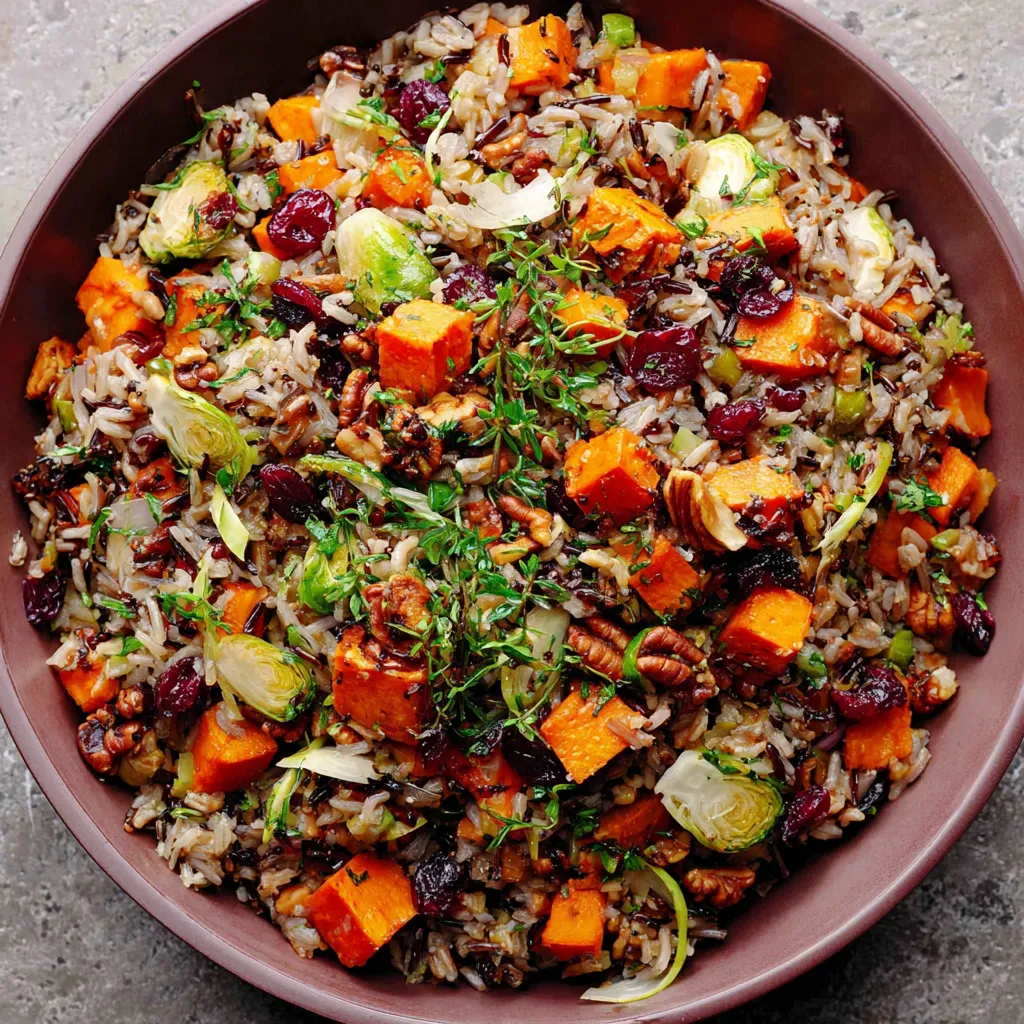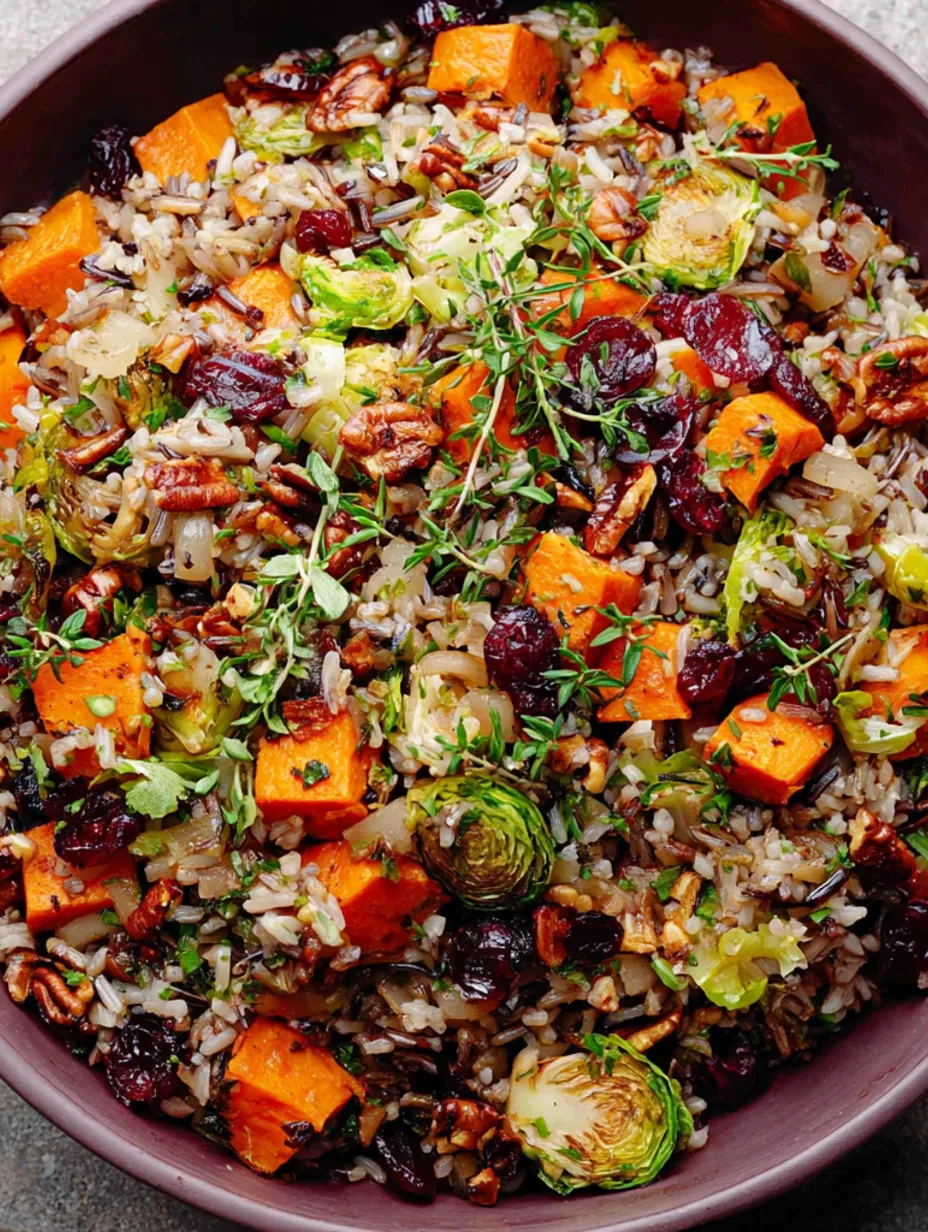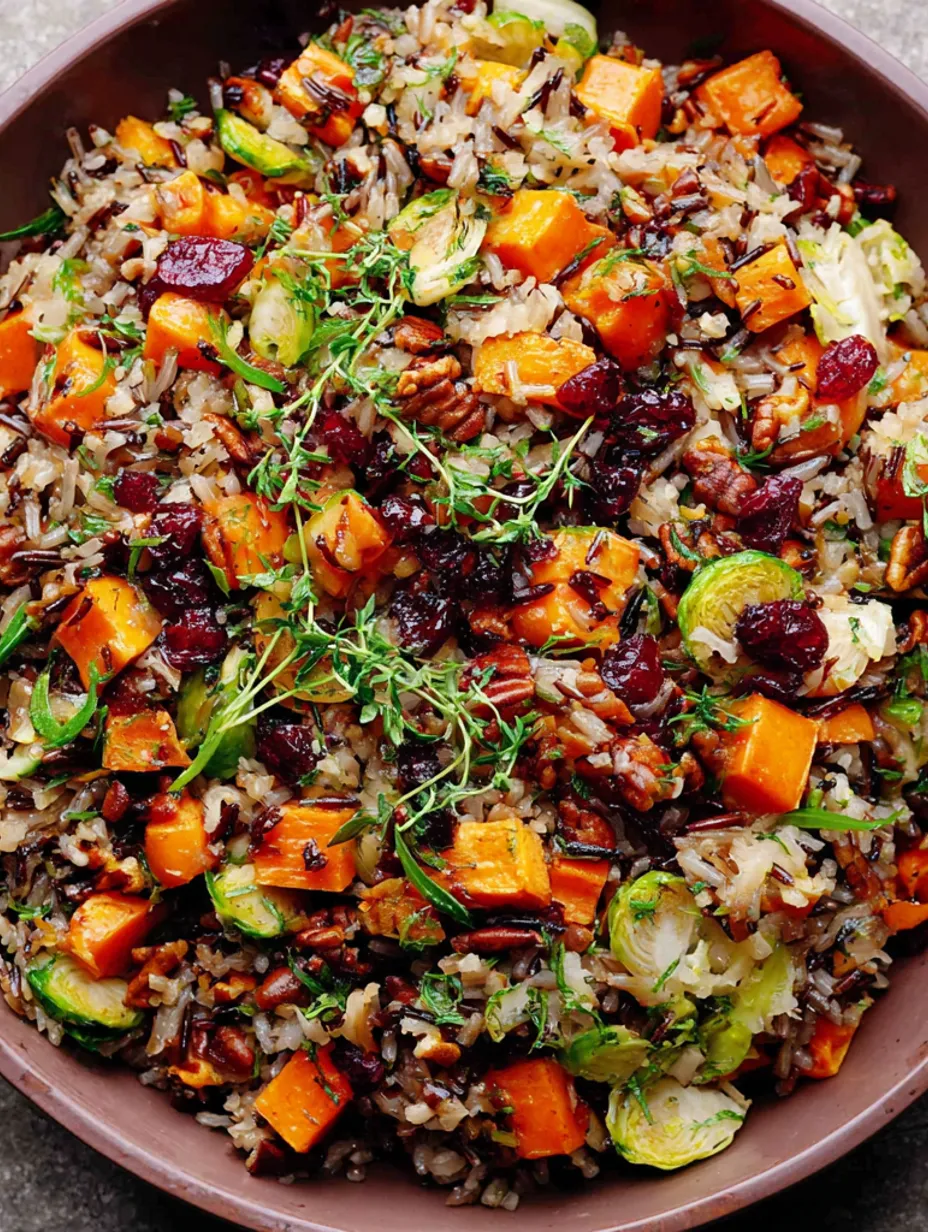 Bookmark
Bookmark
This wild rice pilaf transforms simple pantry staples into an elegant side dish that bridges the gap between everyday comfort and holiday sophistication. The chewy texture of wild rice paired with caramelized sweet potatoes and the fresh crunch of Brussels sprouts creates layers of flavor and texture that make every bite interesting.
I discovered this combination during a particularly busy fall when I needed something that could work double duty as both a satisfying weekday lunch and a presentable holiday dish. The magic happens when the warm rice slightly wilts the raw Brussels sprouts, creating the perfect balance between cooked and fresh elements.
Ingredients
- Brown rice and wild rice blend: provides the perfect chewy texture while cooking faster than pure wild rice
- Sweet potato: becomes beautifully caramelized when roasted, adding natural sweetness and vibrant color
- Shallots: develop a silky texture and deep umami flavor when roasted alongside the sweet potatoes
- Brussels sprouts: stay crisp and fresh, offering a peppery contrast to the roasted vegetables
- Fresh garlic: adds sharp, savory depth that ties all the flavors together
- Dried cranberries: contribute bursts of sweet tartness that brighten each bite
- Toasted pecans: bring essential crunch and rich, buttery flavor
- Fresh thyme and parsley: create an aromatic herb blend that makes the dish feel special
- Extra virgin olive oil: acts as the binding agent that marries all the flavors
- Apple cider vinegar: adds a subtle tang that enhances all the other flavors
Step by Step Instructions
- Prepare Your Workspace:
- Preheat your oven to 425°F and line a large baking sheet with parchment paper. This high temperature ensures the vegetables caramelize properly rather than just steaming. Have all your ingredients prepped and ready since the final assembly moves quickly once the rice is cooked.
- Cook the Rice Base:
- Combine the rinsed rice blend with water and one teaspoon of olive oil in a medium saucepan. The oil prevents sticking and adds richness. Bring to a vigorous boil, then immediately cover and reduce to low heat. Simmer for exactly 45 minutes without lifting the lid, then remove from heat and let stand covered for 10 minutes. This resting time allows the grains to finish cooking in their own steam.
- Roast the Vegetables:
- While the rice cooks, cube your sweet potato into uniform half inch pieces for even cooking. Cut shallots into larger chunks since they shrink more than sweet potatoes. Toss both with olive oil, salt, and pepper, then spread in a single layer on your prepared baking sheet. Roast for 20 to 25 minutes until the edges are golden brown and caramelized.
- Season the Warm Rice:
- Once the rice has rested, fluff it gently with a fork to separate the grains. While still warm, toss with the remaining olive oil, apple cider vinegar, grated garlic, fresh thyme, salt, and several generous grinds of black pepper. The warm rice absorbs these flavors much better than cold rice would.
- Final Assembly:
- Add the shaved Brussels sprouts first, allowing them to wilt slightly from the heat of the rice. Then fold in the roasted sweet potatoes and shallots, dried cranberries, chopped pecans, and fresh parsley. Toss everything together gently but thoroughly, taste, and adjust seasoning as needed. Garnish with additional fresh parsley leaves before serving.
 Bookmark
Bookmark
The secret to this pilaf is the Brussels sprouts. I was skeptical about using them raw at first, but their slight bitterness and crisp texture provide the perfect counterpoint to all the sweet, roasted elements. My family now requests this dish for every major gathering, and I always make extra knowing the leftovers disappear quickly from lunch boxes.
Storage and Make Ahead Tips
This pilaf actually improves with time as the flavors meld together. Store covered in the refrigerator for up to three days, and don't worry about reheating unless you prefer it warm. The room temperature texture is actually ideal for showcasing all the different elements. If you do want to reheat, add a splash of water or broth and warm gently to prevent the rice from drying out.
Smart Substitutions
The beauty of this recipe lies in its flexibility. Swap the wild rice blend for farro or wheat berries for different textures. Butternut squash or delicata squash work beautifully in place of sweet potatoes, and kale can replace Brussels sprouts if you prefer. For the dried fruit, try tart cherries or chopped dried apricots. Even the nuts can be switched to walnuts or toasted pumpkin seeds for different flavor profiles.
Perfect Pairings
While this pilaf shines as a standalone lunch, it's equally at home on holiday tables alongside traditional dishes. The earthy flavors complement both rich gravies and lighter vinaigrettes. I particularly love serving it with roasted meats or as part of a vegetarian feast. The colors are stunning next to green bean casseroles and cranberry sauces, making your table look professionally styled.
 Bookmark
Bookmark
Cultural Connections
Wild rice holds deep cultural significance for many Native American communities, particularly in the Great Lakes region where it grows naturally in shallow waters. This pilaf honors that tradition while incorporating ingredients that reflect modern American tastes. The combination technique draws from Middle Eastern pilaf traditions, creating a dish that feels both rooted and contemporary.
Frequently Asked Questions About Recipes
- → What type of rice works best for this pilaf?
A blend of wild rice and long grain brown rice provides great texture and flavor but 100 percent wild rice also works well.
- → Can I substitute the sweet potatoes?
Yes roasted butternut squash delicata squash carrots or sautéed mushrooms make excellent alternatives.
- → Is it possible to make this dish ahead of time?
Absolutely this pilaf keeps well for up to three days refrigerated and can be served warm or at room temperature.
- → How do I prepare the vegetables?
Sweet potatoes and shallots are roasted until tender and caramelized while Brussels sprouts are shaved and added fresh for contrast.
- → What herbs complement this pilaf?
Fresh thyme and parsley add aromatic freshness and enhance the overall flavor profile.
- → Can I add a dressing to this pilaf?
Yes tossing the pilaf with an apple cider vinegar dressing adds brightness and depth if desired.
